Application of Remote Sensing, GIS and Machine Learning with Geographically Weighted Regression in Assessing the Impact of Hard Coal Mining on the Natural Environment
Abstract
1. Introduction
2. Materials
2.1. Study Area Description
2.2. Meteorological Data
2.3. Identification of Flooding Areas Based on the Optical Satellite Data Analysis
2.4. InSAR Terrain Displacement Data
2.5. Geological and Hydrogeological Data
- Up to 1 m below ground level.
- Between 1–2m below ground level.
- More than 2 m below ground level.
- Organic soils.
- Poorly permeable silts, loams and clays.
- Permeable sands and gravels.
3. Methods—GIS and Machine Learning Analysis
3.1. Overview
3.2. Preliminary Statistical Analysis
3.3. Machine Learning Global Model
3.4. Geographically Weighted Regression (GWR) Local Modeling
4. Results and Discussion
4.1. Preliminary Statistical Analysis
4.2. Machine Learning Global Model
4.3. GWR Local Modeling
4.4. Summary
5. Conclusions
Author Contributions
Funding
Conflicts of Interest
Abbreviations
| AICc | Akaike Information Criterion with a correction for small sample sizes |
| CCR | Central Coal Region |
| DN | Digital Number |
| DEM | Digital Elevation Model |
| GIS | Geographic Information Systems |
| GWR | Geographically Weighted Regression |
| InSAR | Interferometric Synthetic Aperture Radar |
| LCB | Lublin Coal Basin |
| LOS | Line of Sight |
| MNDWI | Modified Normalized Difference Water Index |
| NDVI | Normalized Difference Vegetation Index |
| RF | Random Forest |
| SAR | Synthetic Aperture Radar |
| SBAS | Small Baseline Subset |
| SHAP | SHapley Additive exPlanations |
| SNAPHU | Statistical-cost Network-flow Algorithm for Phase Unwrapping |
| SRTM | Shuttle Radar Topography Mission |
| UTM | Universal Transverse Mercator |
References
- Klukanová, A.; Rapant, S. Impact of mining activities upon the environment of the Slovak Republic: Two case studies. J. Geochem. Explor. 1999, 66, 299–306. [Google Scholar] [CrossRef]
- Chauhan, S.S. Mining, Development and Environment: A Case Study of Bijolia Mining Area in Rajasthan, India. J. Hum. Ecol. 2010, 31, 65–72. [Google Scholar] [CrossRef]
- Majumder, S.; Sarkar, K. Impact of mining and related activities on physical and cultural environment of Singrauli Coalfield—A case study through application of remote sensing techniques. J. Indian Soc. Remote Sens. 1994, 22, 45–56. [Google Scholar] [CrossRef]
- Nichols, O.G.; Carbon, B.A.; Colquhoun, I.J.; Croton, J.T.; Murray, N.J. Rehabilitation after bauxite mining in south-western australia. Landsc. Plan. 1985, 12, 75–92. [Google Scholar] [CrossRef]
- Sklenicka, P.; Prikyl, I. Non-productive principles of landscape rehabilitation after long-term opencast mining in north-west Bohemia. J. S. Afr. Inst. Min. Metall. 2004, 104, 83–88. [Google Scholar]
- Lechner, A.M.; Kassulke, O.; Unger, C. Spatial assessment of open cut coal mining progressive rehabilitation to support the monitoring of rehabilitation liabilities. Resour. Policy 2016, 50, 234–243. [Google Scholar] [CrossRef]
- Kwinta, A.; Gradka, R. Mining exploitation influence range. Nat. Hazards 2018, 94, 979–997. [Google Scholar] [CrossRef]
- Kwinta, A.; Gradka, R. Analysis of the damage influence range generated by underground mining. Int. J. Rock Mech. Min. Sci. 2020, 128, 104263. [Google Scholar] [CrossRef]
- Blachowski, J.; Milczarek, W. Analysis of surface changes in the Walbrzych hard coal mining grounds (SW Poland) between 1886 and 2009. Geol. Q. 2014, 58, 353–368. [Google Scholar] [CrossRef]
- Blachowski, J.; Kopec, A.; Milczarek, W.; Owczarz, K. Evolution of Secondary Deformations Captured by Satellite Radar Interferometry: Case Study of an Abandoned Coal Basin in SW Poland. Sustainability 2019, 11, 884. [Google Scholar] [CrossRef]
- Szczepiński, J. The Significance of Groundwater Flow Modeling Study for Simulation of Opencast Mine Dewatering, Flooding, and the Environmental Impact. Water 2019, 11, 848. [Google Scholar] [CrossRef]
- Currell, M.J.; Werner, A.D.; McGrath, C.; Webb, J.A.; Berkman, M. Problems with the application of hydrogeological science to regulation of Australian mining projects: Carmichael Mine and Doongmabulla Springs. J. Hydrol. 2017, 548, 674–682. [Google Scholar] [CrossRef]
- Milczarek, W. Investigation of post inducted seismic deformation of the 2016 MW 4.2 Tarnowek Poland mining tremor based on DinSAR and SBAS method. Acta Geodyn. Geomater. 2019, 16, 183–193. [Google Scholar] [CrossRef]
- Hejmanowski, R.; Malinowska, A.A.; Witkowski, W.T.; Guzy, A. An Analysis Applying InSAR of Subsidence Caused by Nearby Mining-Induced Earthquakes. Geosciences 2019, 9, 490. [Google Scholar] [CrossRef]
- Sonter, L.J.; Moran, C.J.; Barrett, D.J.; Soares-Filho, B.S. Processes of land use change in mining regions. J. Clean. Prod. 2014, 84, 494–501. [Google Scholar] [CrossRef]
- Redondo-Vega, J.M.; Gómez-Villar, A.; Santos-González, J.; González-Gutiérrez, R.B.; Álvarez-Martínez, J. Changes in land use due to mining in the north-western mountains of Spain during the previous 50years. Catena 2017, 149, 844–856. [Google Scholar] [CrossRef]
- Malinowska, A.; Hejmanowski, R. Building damage risk assessment on mining terrains in Poland with GIS application. Int. J. Rock Mech. Min. Sci. 2010, 47, 238–245. [Google Scholar] [CrossRef]
- Florkowska, L. Example building damage caused by mining exploitation in disturbed rock mass. Stud. Geotech. Mech. 2013, 35, 19–37. [Google Scholar] [CrossRef]
- Brinson, M.M. A Hydrogeomorphic Classification for Wetlands; U.S. Army Engineer Waterways Experiment Station: Vicksburg, MS, USA, 1993; pp. 1–103. [Google Scholar]
- Padmanaban, R.; Bhowmik, A.K.; Cabral, P. A Remote Sensing Approach to Environmental Monitoring in a Reclaimed Mine Area. ISPRS Int. J. Geo-Inf. 2017, 6, 401. [Google Scholar] [CrossRef]
- Charou, E.; Stefouli, M.; Dimitrakopoulos, D.; Vasiliou, E.; Mavrantza, O.D. Using Remote Sensing to Assess Impact of Mining Activities on Land and Water Resources. Mine Water Environ. 2010, 29, 45–52. [Google Scholar] [CrossRef]
- Paull, D.; Banks, G.; Ballard, C.; Gillieson, D. Monitoring the Environmental Impact of Mining in Remote Locations through Remotely Sensed Data. Geocarto Int. 2006, 21, 33–42. [Google Scholar] [CrossRef]
- Miatkowski, Z.; Kowalik, W.; Lewiński, S.; Sołtysik, A.; Turbiak, J. Assessment of Possibilities of Satellite Remote Sensing use for the Identification of Hydrogenic Habitats Transformations under the Influence of Deep Drainage in the Region of the Bełchatów Brown Coal Mine. (In Polish with English summary). Available online: http://warsztatygornicze.pl/wp-content/uploads/2004_36.pdf (accessed on 10 November 2020).
- Wang, X.; Nie, H.-F.; Li, C.-Z.; Wang, J. Application of different data sources in the investigation of exploitation situation and environment of mines. Remote Sens. Land Resour. 2006, 68, 69–71. [Google Scholar] [CrossRef]
- Schmidt, H.; Glaesser, C. Multitemporal analysis of satellite data and their use in the monitoring of the environmental impacts of open cast lignite mining areas in Eastern Germany. Int. J. Remote Sens. 1998, 19, 2245–2260. [Google Scholar] [CrossRef]
- Duan, H.; Deng, Z.; Deng, F.; Wang, D. Assessment of Groundwater Potential Based on Multicriteria Decision Making Model and Decision Tree Algorithms. Available online: https://www.hindawi.com/journals/mpe/2016/2064575/ (accessed on 6 September 2020).
- Baek, J.; Kim, S.-W.; Park, H.-J.; Jung, H.-S.; Kim, K.-D.; Kim, J.W. Analysis of ground subsidence in coal mining area using SAR interferometry. Geosci. J. 2008, 12, 277–284. [Google Scholar] [CrossRef]
- Zhao, C.; Lu, Z.; Zhang, Q. Time-series deformation monitoring over mining regions with SAR intensity-based offset measurements. Remote Sens. Lett. 2013, 4, 436–445. [Google Scholar] [CrossRef]
- Samsonov, S.; D’Oreye, N.; Smets, B. Ground deformation associated with post-mining activity at the French–German border revealed by novel InSAR time series method. Int. J. Appl. Earth Obs. Geoinf. 2013, 23, 142–154. [Google Scholar] [CrossRef]
- Gee, D.; Bateson, L.; Sowter, A.; Grebby, S.; Novellino, A.; Cigna, F.; Marsh, S.; Banton, C.; Wyatt, L. Ground Motion in Areas of Abandoned Mining: Application of the Intermittent SBAS (ISBAS) to the Northumberland and Durham Coalfield, UK. Geosciences 2017, 7, 85. [Google Scholar] [CrossRef]
- Bateson, L.; Cigna, F.; Boon, D.; Sowter, A. The application of the Intermittent SBAS (ISBAS) InSAR method to the South Wales Coalfield, UK. Int. J. Appl. Earth Obs. Geoinf. 2015, 34, 249–257. [Google Scholar] [CrossRef]
- Zhao, Y.; Li, Y.; Zhang, L.; Wang, Q. Groundwater level prediction of landslide based on classification and regression tree. Geodesy Geodyn. 2016, 7, 348–355. [Google Scholar] [CrossRef]
- Zhu, X.; Xu, Q.; Tang, M.; Nie, W.; Ma, S.; Xu, Z. Comparison of two optimized machine learning models for predicting displacement of rainfall-induced landslide: A case study in Sichuan Province, China. Eng. Geol. 2017, 218, 213–222. [Google Scholar] [CrossRef]
- Karimi, S.S.; Saintilan, N.; Wen, L.; Valavi, R. Application of Machine Learning to Model Wetland Inundation Patterns Across a Large Semiarid Floodplain. Water Resour. Res. 2019, 55, 8765–8778. [Google Scholar] [CrossRef]
- Bońda, R.; Brzeziński, D.; Czapigo-Czapla, M.; Czapowski, G.; Fabiańczyk, J.; Kalinowska, A.; Malon, A.; Mazurek, S.; Mikulski, S.Z.; Miśkiewicz, W.; et al. Balance of Mineral Resources in Poland as at 31 December 2019; Polish Geological Institute–National Research Institute: Warsaw, Poland, 2020. [Google Scholar]
- Lubelski Coal “Bogdanka” Characteristics of Coal Deposit. 2018. Available online: https://www.lw.com.pl/en,2,s169.html (accessed on 10 September 2020).
- Stachowicz, S. Current Problems of Exploitations of Hard Coal in “Bogdanka” Mine in Lublin Coal Basin (LZW). (In Polish with English Summary). Available online: http://warsztatygornicze.pl/wp-content/uploads/2005-1.pdf (accessed on 10 November 2020).
- Stupicka, E.; Stempień-Sałek, M. Regional Geology of Poland; University of Warsaw Publishing House: Warsaw, Poland, 2019; pp. 161–168. ISBN 978-83-235-2022-1. (In Polish) [Google Scholar]
- Bulletins of the Polish Institute of Meteorology and Water Management; Institute of Meteorology and Water Management–National Research Institute: Warsaw, Poland, 2015.
- U.S. Geological Survey, EarthExplorer. Available online: https://earthexplorer.usgs.gov/ (accessed on 15 August 2020).
- Osińska-Skotak, K. The Importance of Radiometric Correction in Sarellite Images. Arch. Photogramm. Cartogr. Remote Sens. 2007, 17, 577–590, (In Polish with English summary). [Google Scholar]
- Harris Geospatial Solutions, Inc. Fast Line-of-Sight Atmospheric Analysis of Hypercubes (FLAASH). Available online: https://www.l3harrisgeospatial.com/docs/FLAASH.html (accessed on 17 August 2020).
- Bell, G.E. Turfgrass Physiology and Ecology: Advanced Management Principles; CABI: Wallingford, UK, 2011; ISBN 978-1-84593-648-8. [Google Scholar]
- Acharya, T.D.; Lee, D.H.; Yang, I.T.; Lee, J.K. Identification of Water Bodies in a Landsat 8 OLI Image Using a J48 Decision Tree. Sensors 2016, 16, 1075. [Google Scholar] [CrossRef] [PubMed]
- Berardino, P.; Fornaro, G.; Lanari, R.; Sansosti, E. A new algorithm for surface deformation monitoring based on small baseline differential SAR interferograms. IEEE Trans. Geosci. Remote Sens. 2002, 40, 2375–2383. [Google Scholar] [CrossRef]
- Schmidt, D.A.; Bürgmann, R. Time-dependent land uplift and subsidence in the Santa Clara valley, California, from a large interferometric synthetic aperture radar data set. J. Geophys. Res. Solid Earth 2003, 108. [Google Scholar] [CrossRef]
- Tong, X.; Schmidt, D. Active movement of the Cascade landslide complex in Washington from a coherence-based InSAR time series method. Remote Sens. Environ. 2016, 186, 405–415. [Google Scholar] [CrossRef]
- Sandwell, D.T.; Mellors, R.J.; Tong, X.; Wei, M.; Wessel, P. Open radar interferometry software for mapping surface Deformation. Eos Trans. Am. Geophys. Union 2011, 92, 234. [Google Scholar] [CrossRef]
- European Space Agency, Sentinel-1 Quality Control. Available online: https://qc.sentinel1.eo.esa.int/ (accessed on 19 February 2020).
- Farr, T.G.; Rosen, P.A.; Caro, E.; Crippen, R.; Duren, R.; Hensley, S.; Kobrick, M.; Paller, M.; Rodriguez, E.; Roth, L.; et al. The Shuttle Radar Topography Mission. Rev. Geophys. 2007, 45. [Google Scholar] [CrossRef]
- Chen, C.W.; Zebker, H.A. Network approaches to two-dimensional phase unwrapping: Intractability and two new algorithms. J. Opt. Soc. Am. A 2000, 17, 401–414. [Google Scholar] [CrossRef]
- Chen, C.W.; Zebker, H.A. Two-dimensional phase unwrapping with use of statistical models for cost functions in nonlinear optimization. J. Opt. Soc. Am. A 2001, 18, 338–351. [Google Scholar] [CrossRef]
- Chen, C.W.; Zebker, H.A. Phase unwrapping for large SAR interferograms: Statistical segmentation and generalized network models. IEEE Trans. Geosci. Remote Sens. 2002, 40, 1709–1719. [Google Scholar] [CrossRef]
- Liszkowski, J. Detailed Geological Map of Poland 1:50 000, Sheet 714 (Ostrów Lubelski); Polish Geological Institute–National Research Institute: Warsaw, Poland, 1977. [Google Scholar]
- Czerwińska-Tomczyk, J.; Łusiak, R. Hydrogeological Map of Poland 1:50 000, First Aquifer, Occurrence and Hydrodynamics, Sheet 714 (Ostrów Lubelski); Polish Geological Institute–National Research Institute: Warsaw, Poland, 2005. [Google Scholar]
- Buraczyński, J.; Wojtanowicz, J. Detailed Geological Map of Poland 1:50 000, Sheet 715 (Orzechów Nowy); Polish Geological Institute–National Research Institute: Warsaw, Poland, 1979. [Google Scholar]
- Rysak, A.; Zwoliński, Z. Hydrogeological Map of Poland 1:50 000, First Aquifer, Occurrence and Hydrodynamics, Sheet 715 (Orzechów Nowy); Polish Geological Institute–National Research Institute: Warsaw, Poland, 2005. [Google Scholar]
- Harasimiuk, M.; Henkiel, A. Detailed Geological Map of Poland 1:50 000, Sheet 750 (Łęczna); Polish Geological Institute–National Research Institute: Warsaw, Poland, 1978. [Google Scholar]
- Pietruszka, W.; Zezula, H. Hydrogeological Map of Poland 1:50 000, First Aquifer, Occurrence and Hydrodynamics, Sheet 750 (Łęczna); Polish Geological Institute–National Research Institute: Warsaw, Poland, 2006. [Google Scholar]
- Harasimiuk, M.; Szwajgier, W.; Jezierski, W. Detailed Geological Map of Poland 1:50 000, Sheet 751 (Siedliszcze); Polish Geological Institute–National Research Institute: Warsaw, Poland, 1998. [Google Scholar]
- Zezula, H.; Pietruszka, W. Hydrogeological Map of Poland 1:50 000, First Aquifer, Occurrence and Hydrodynamics, Sheet 751 (Siedliszcze); Polish Geological Institute–National Research Institute: Warsaw, Poland, 2006. [Google Scholar]
- Dowgiałło, J.; Kleczkowski, A.S.; Macioszczyk, T.; Różkowski, A. (Eds.) Hydrogeological Dictionary; Polish Geological Institute–National Research Institute: Warsaw, Poland, 2002. (In Polish) [Google Scholar]
- Frankowski, Z.; Gałkowski, P.; Majer, K. Directions of Use Maps of Areas at Risk of Flooding in May 2010; Polish Geological Institute–National Research Institute: Warsaw, Poland. Available online: https://www.pgi.gov.pl/psh/materialy-informacyjne-psh/artykuly-psh/8851-artykul-2010-kierunki-wykorzystania-mapy-obszarow-zagrozonych-ryzykiem-podtopien-w-majowej-powodzi-2010-roku.html (accessed on 17 August 2020).
- Oliphant, T.E. A Guide to NumPy; Trelgol Publishing: USA, 2006; Volume 1. Available online: https://numpy.org/ (accessed on 25 August 2020).
- Pedregosa, F.; Varoquaux, G.; Gramfort, A.; Michel, V.; Thirion, B.; Grisel, O.; Blondel, M.; Prettenhofer, P.; Weiss, R.; Dubourg, V.; et al. Scikit-learn: Machine learning in Python. J. Mach. Learn. Res. 2011, 12, 2825–2830. [Google Scholar]
- Jordahl, K. GeoPandas: Python Tools for Geographic Data. 2014. Available online: https://github.com/geopandas/geopandas (accessed on 25 August 2020).
- Rey, S.J.; Anselin, L. PySAL: A Python Library of Spatial Analytical Methods. In Handbook of Applied Spatial Analysis; Springer: Berlin/Heidelberg, Germany, 2009; pp. 175–193. [Google Scholar]
- Pal, M. Random forest classifier for remote sensing classification. Int. J. Remote Sens. 2005, 26, 217–222. [Google Scholar] [CrossRef]
- Lundberg, S.M.; Lee, S.-I. A unified approach to interpreting model predictions. In Advances in Neural Information Processing Systems 30; Guyon, I., Luxburg, U.V., Bengio, S., Wallach, H., Fergus, R., Vishwanathan, S., Garnett, R., Eds.; Curran Associates, Inc.: New York, NY, USA, 2017; pp. 4765–4774. [Google Scholar]
- Lundberg, S.M.; Erion, G.; Chen, H.; Degrave, A.; Prutkin, J.M.; Nair, B.; Katz, R.; Himmelfarb, J.; Bansal, N.; Lee, S.-I. From local explanations to global understanding with explainable AI for trees. Nat. Mach. Intell. 2020, 2, 56–67. [Google Scholar] [CrossRef] [PubMed]
- Brunsdon, C.; Fotheringham, A.S.; Charlton, M.E. Geographically Weighted Regression: A Method for Exploring Spatial Nonstationarity. Geogr. Anal. 1996, 28, 281–298. [Google Scholar] [CrossRef]
- Fotheringham, A.S.; Brunsdon, C.; Charlton, M. Geographically Weighted Regression: The Analysis of Spatially Varying Relationships; John Wiley & Sons: Hoboken, NJ, USA, 2003. [Google Scholar]
- Yeo, I.-K.; Johnson, R.A. A new family of power transformations to improve normality or symmetry. Biometrika 2000, 87, 954–959. [Google Scholar] [CrossRef]
- Bielski, P.; Goluch, M.; Koszarna, A.; Kraszewski, P.; Szewczyk, M.; Wojewoda, J.; Dymowski, J. Integrated report GW LW “Bogdanka” for 2016; GK LW “Bogdanka” SA. 2016. Available online: https://ri.lw.com.pl/pub/files/BogdankaRAPORTZINTEGROWANY2016.pdf (accessed on 17 August 2020).
- Król, Ż.; Mikrut, S.; Gabryszuk, J.; Postek, P.; Mazur, A. Changes in the structure of land use in the areas of mining damage. Inżynieria Ekol. Ecol. Eng. 2015, 44, 26–33. [Google Scholar] [CrossRef]
- GW LW “Bogdanka”, Responsible Business Report of the Lubelski Coal Bogdanka Capital Group for 2012–2013; 2013. Available online: https://www.lw.com.pl/pl,2,s428,raport_csr_za_lata_2012-2013.html (accessed on 17 August 2020).
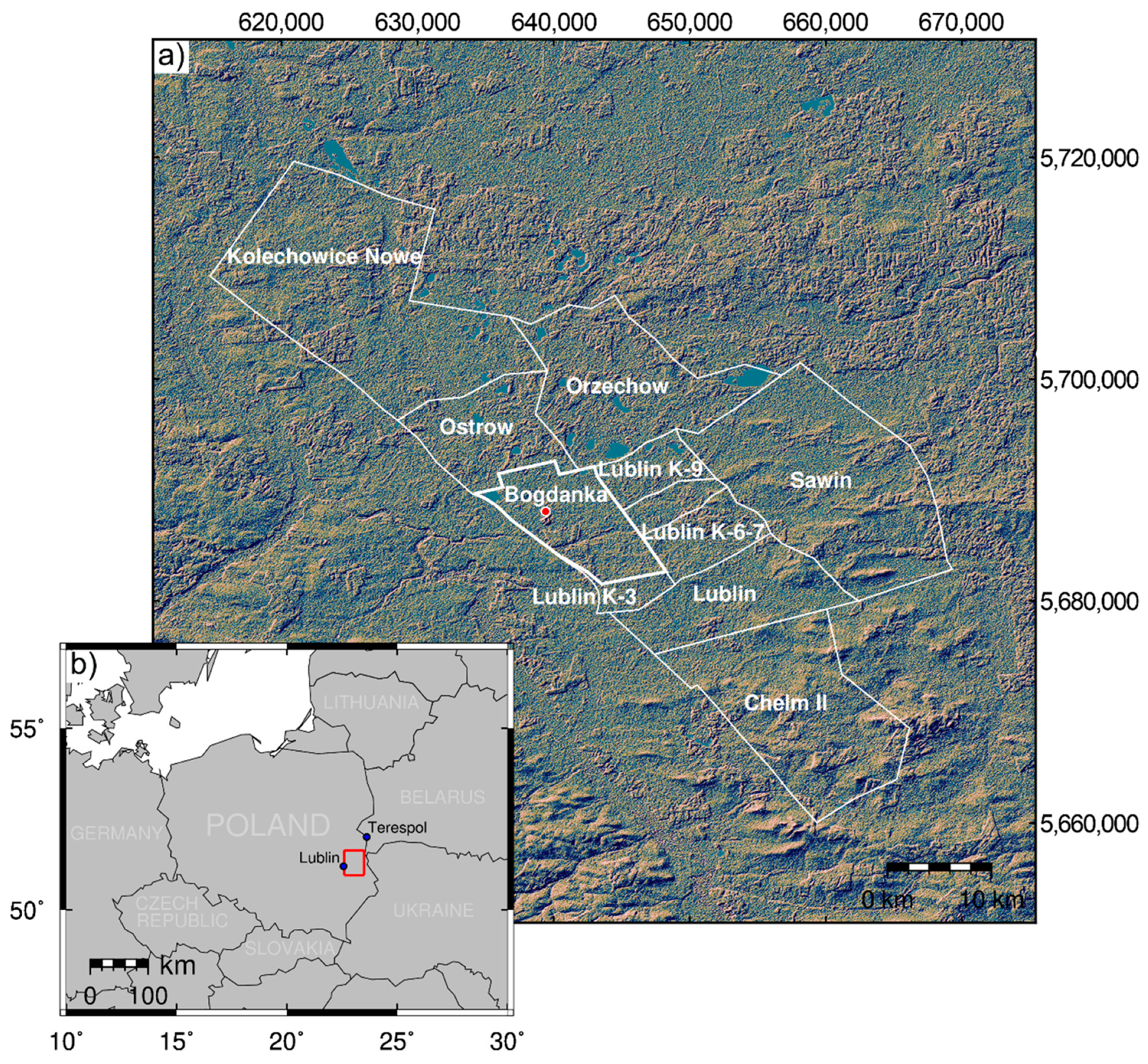
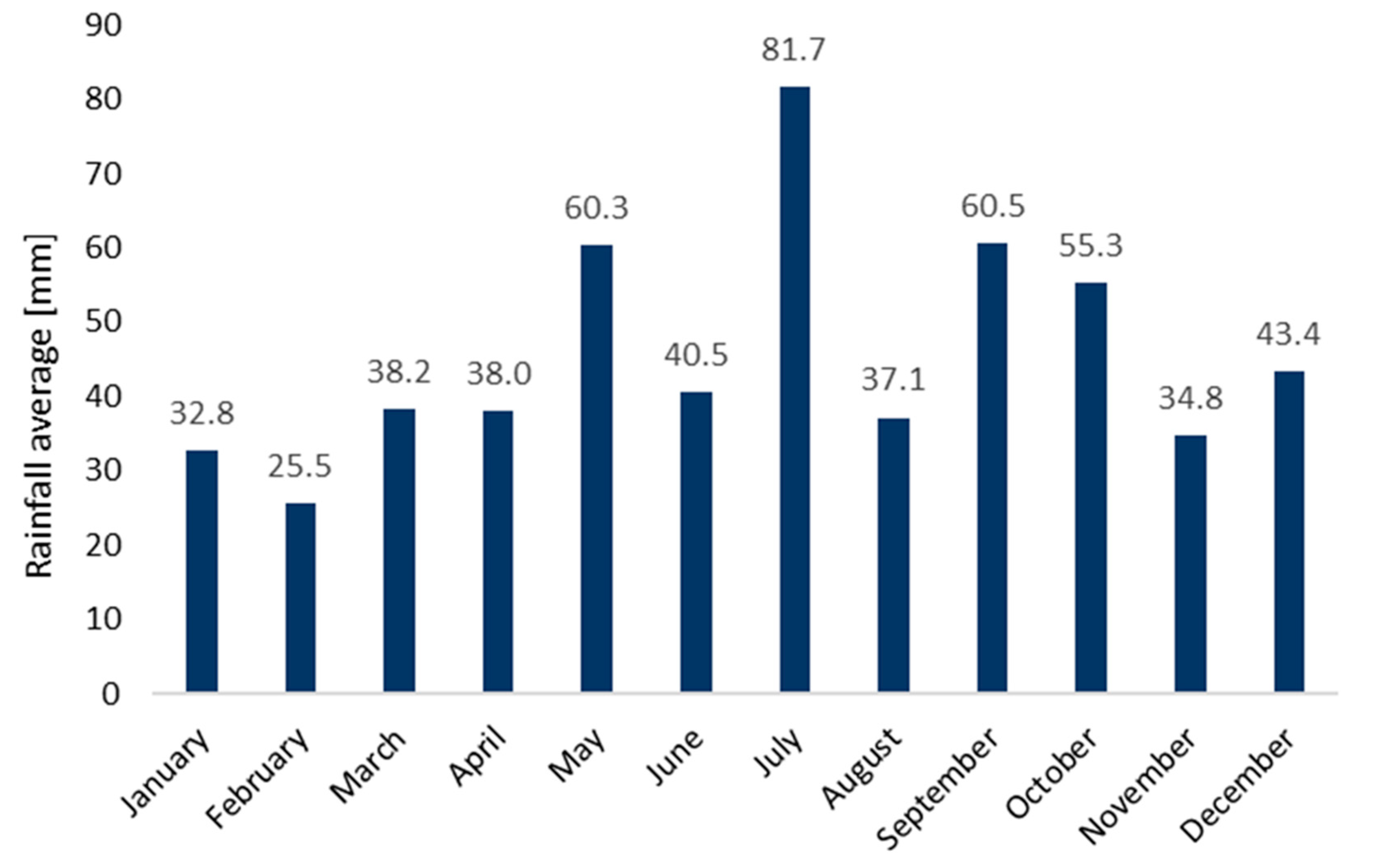
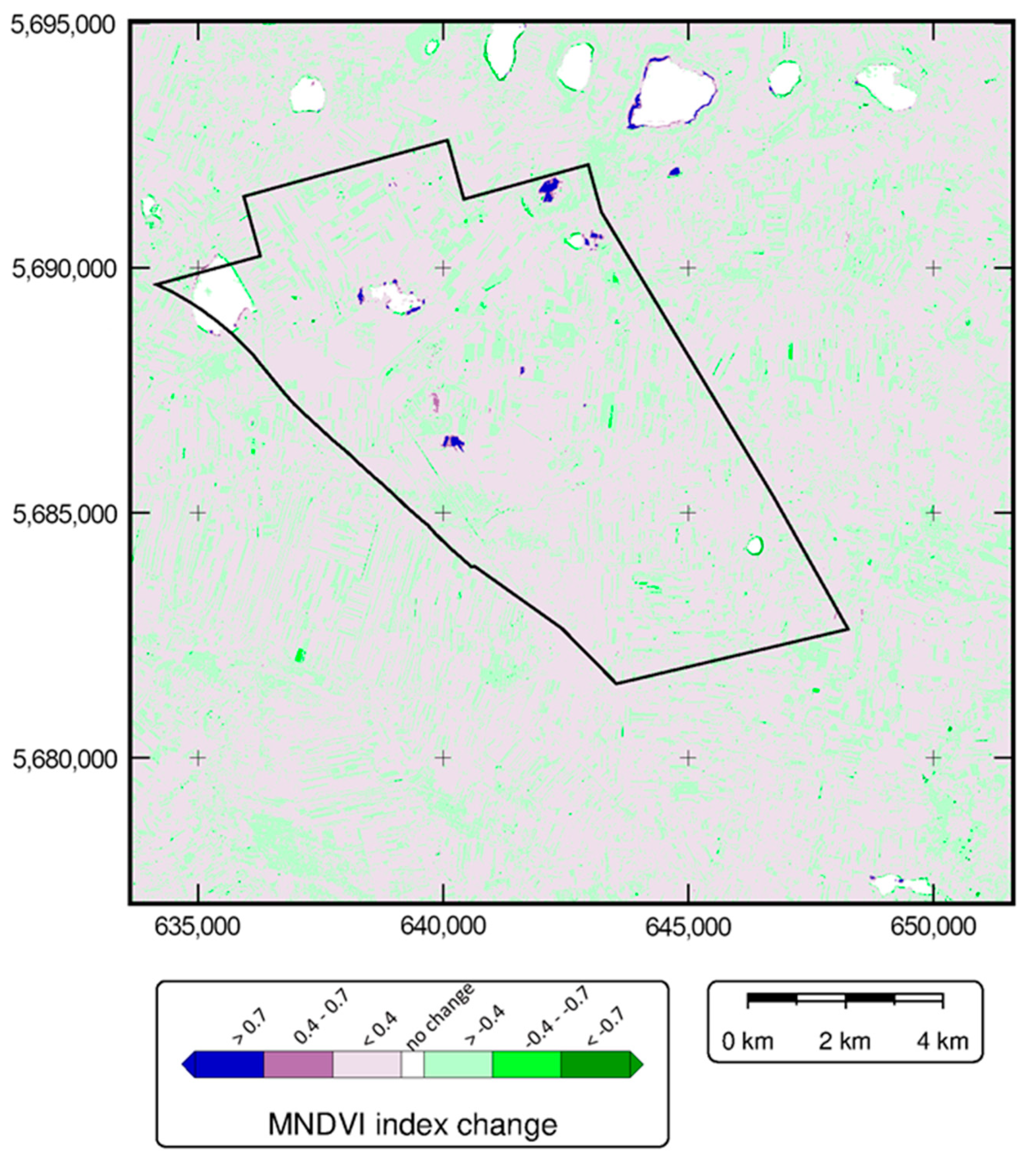
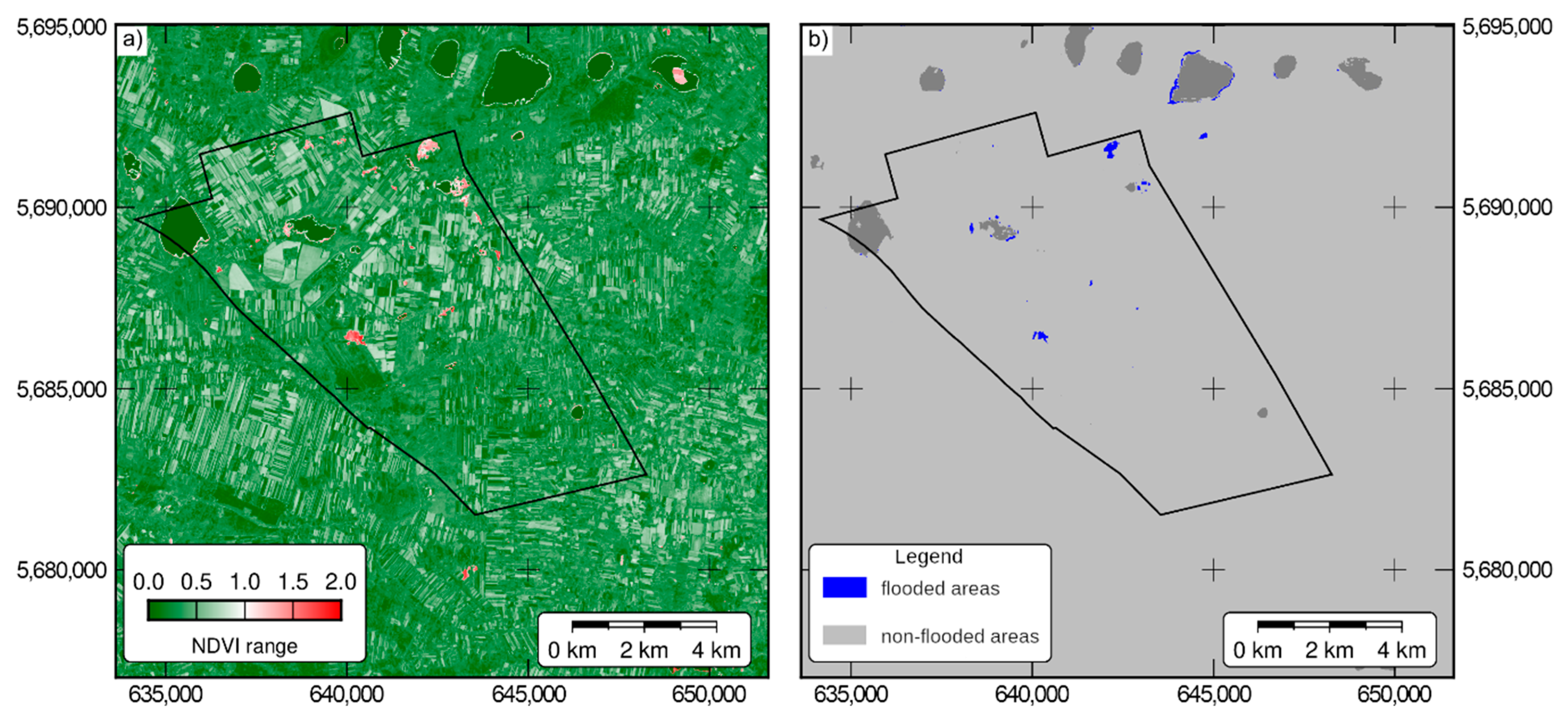
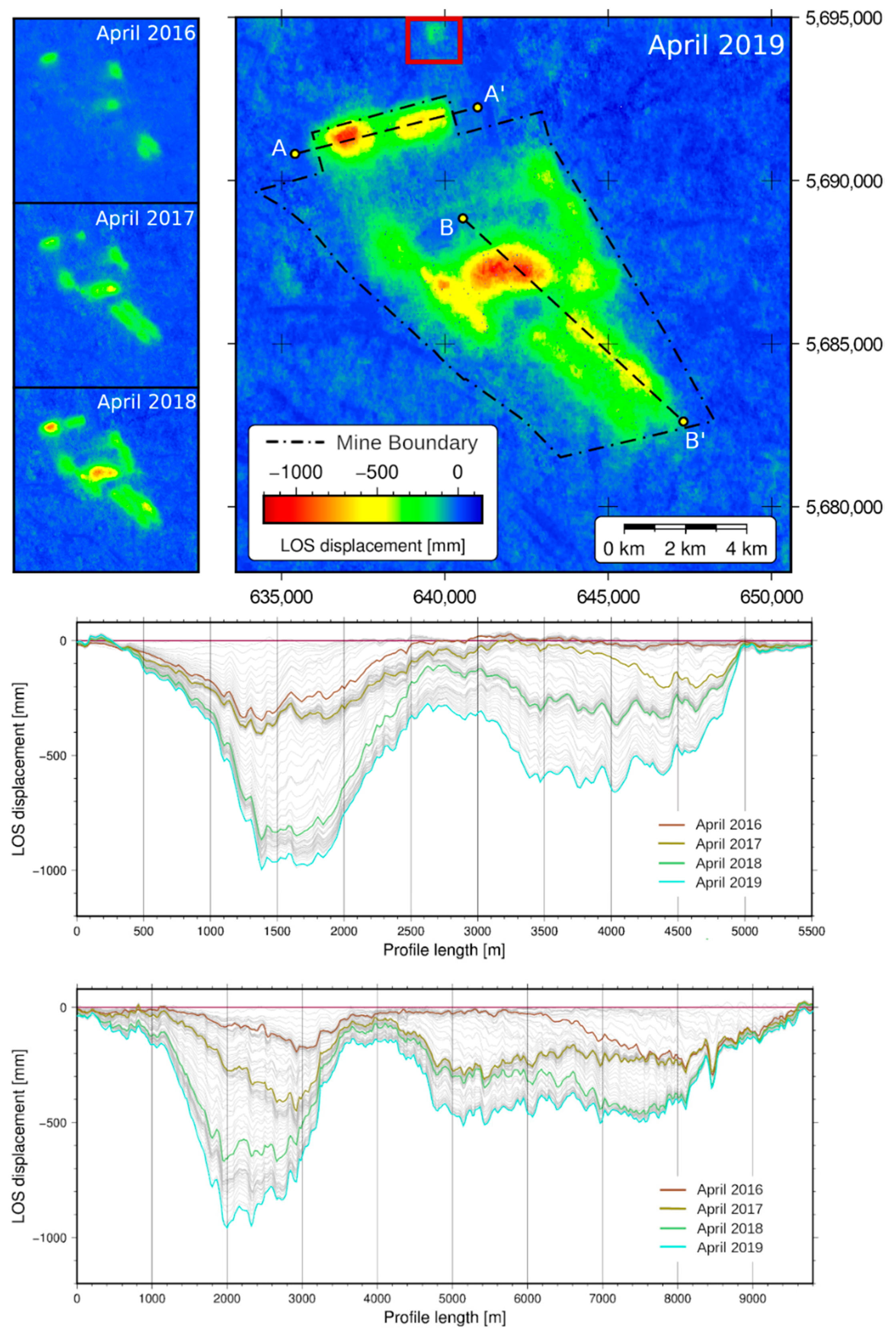
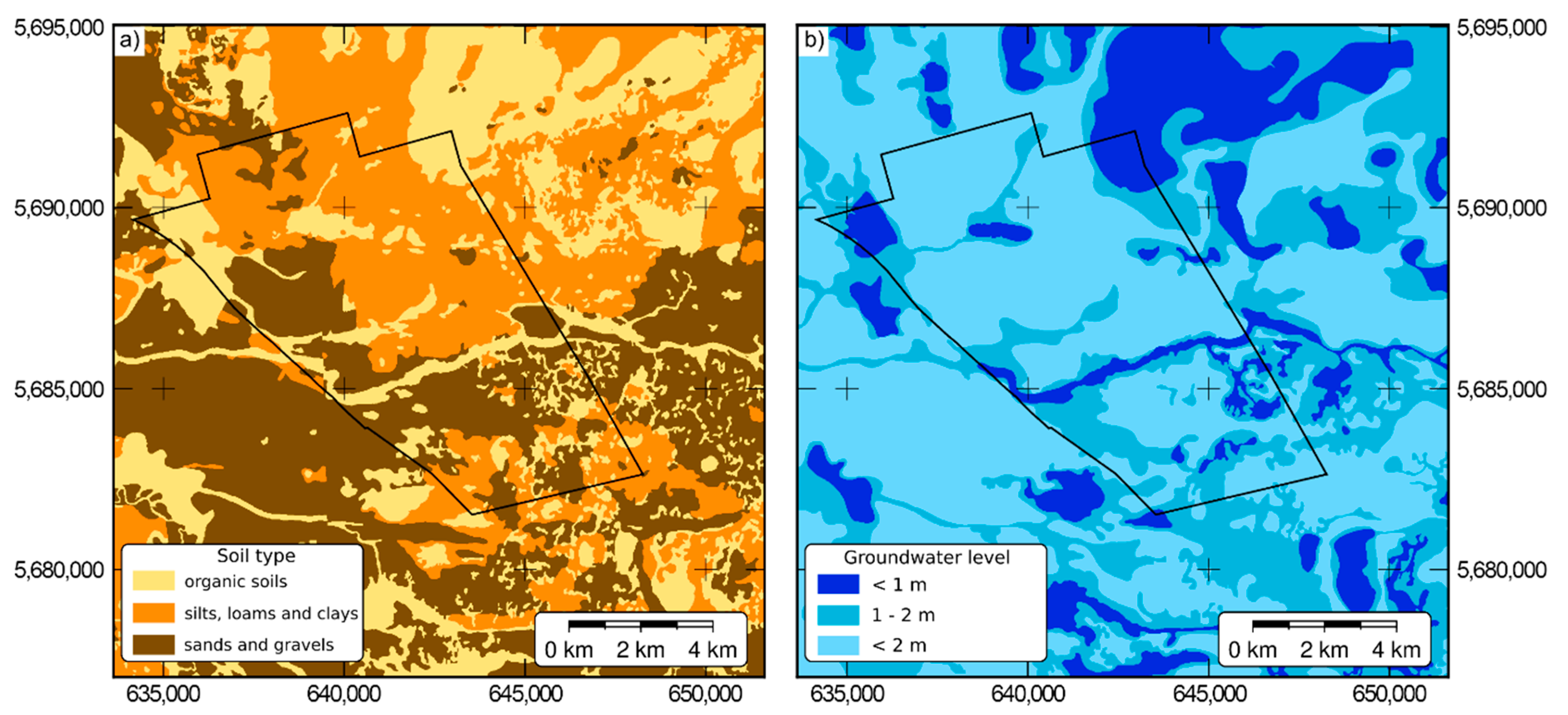

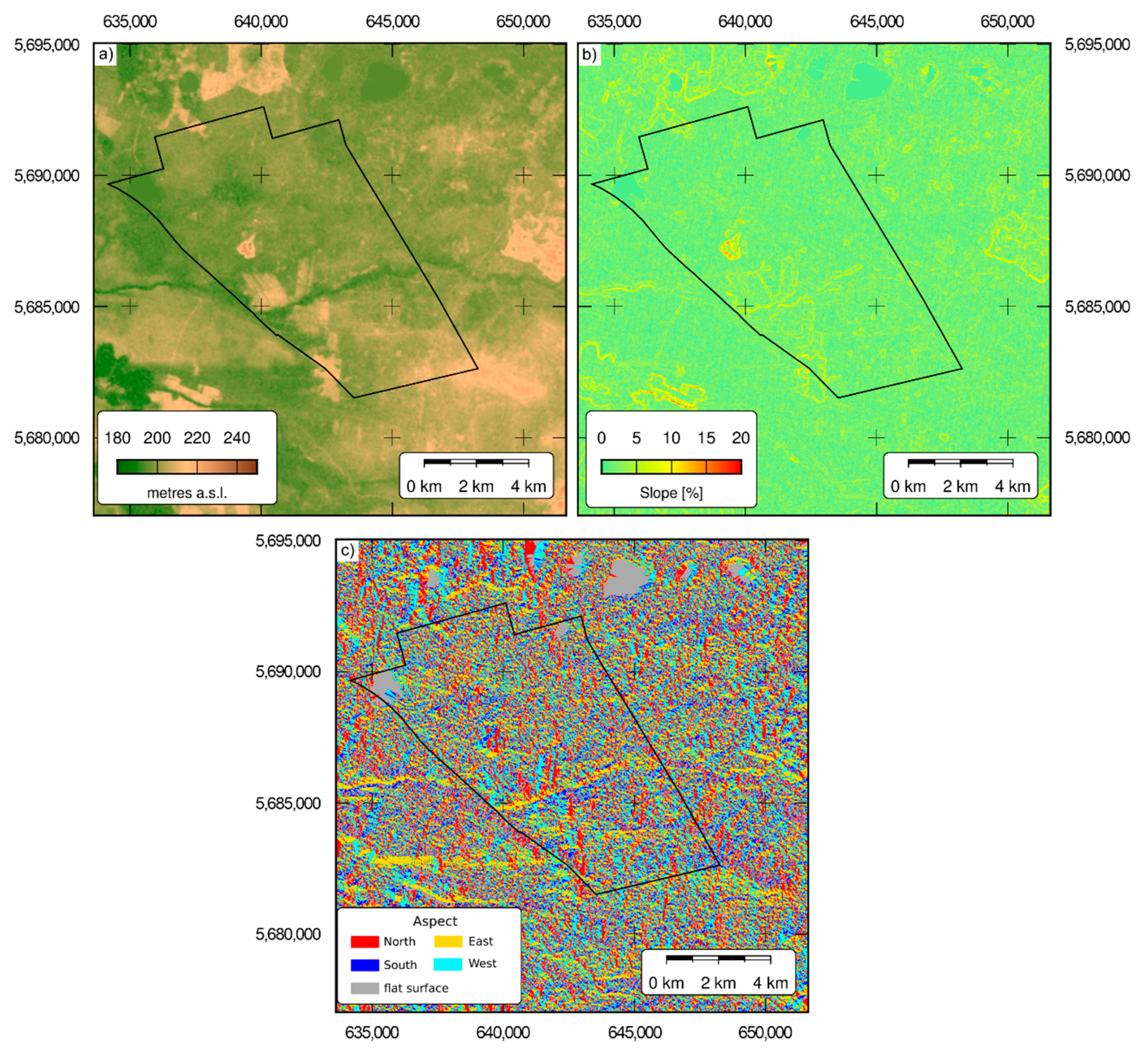
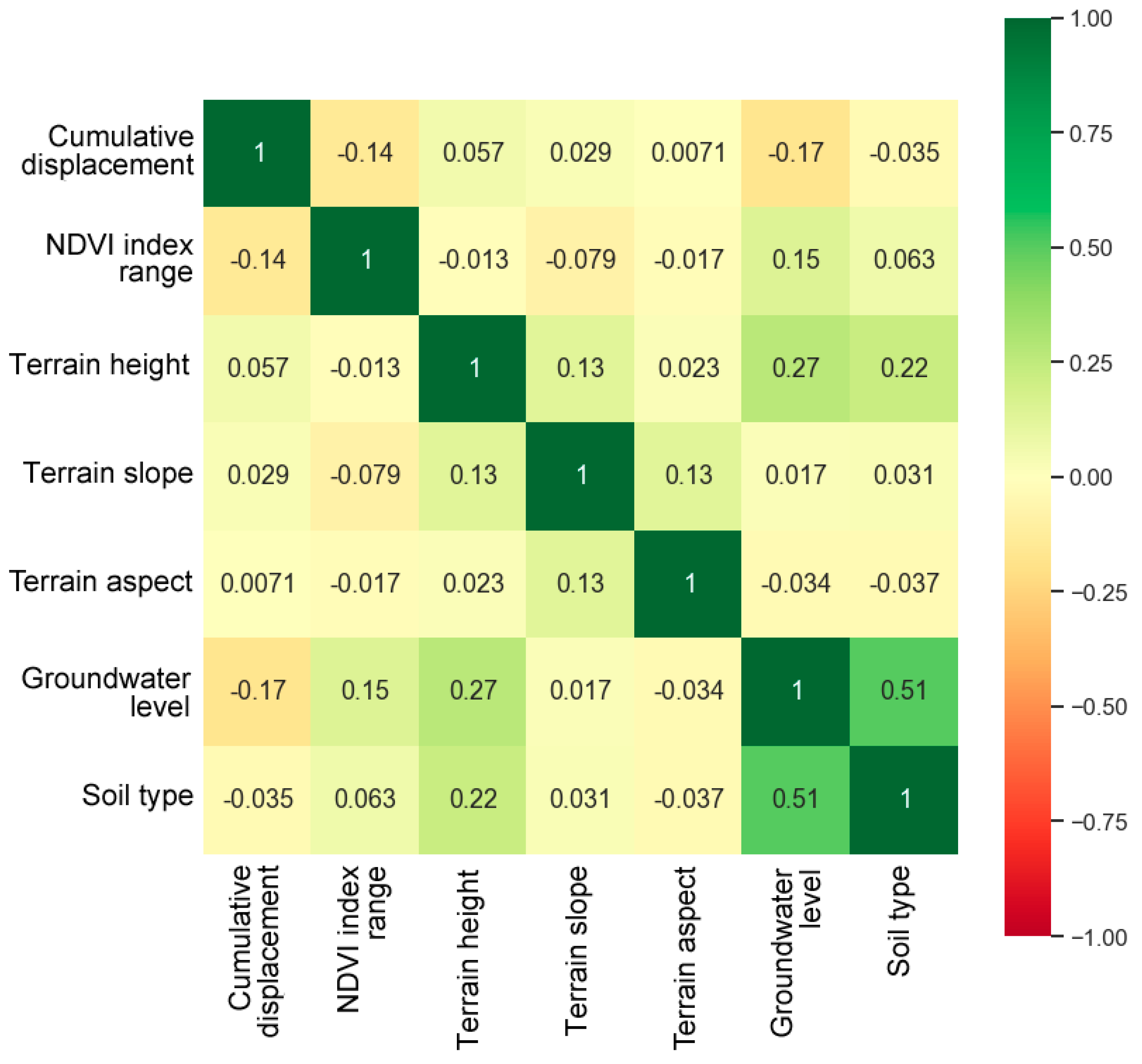
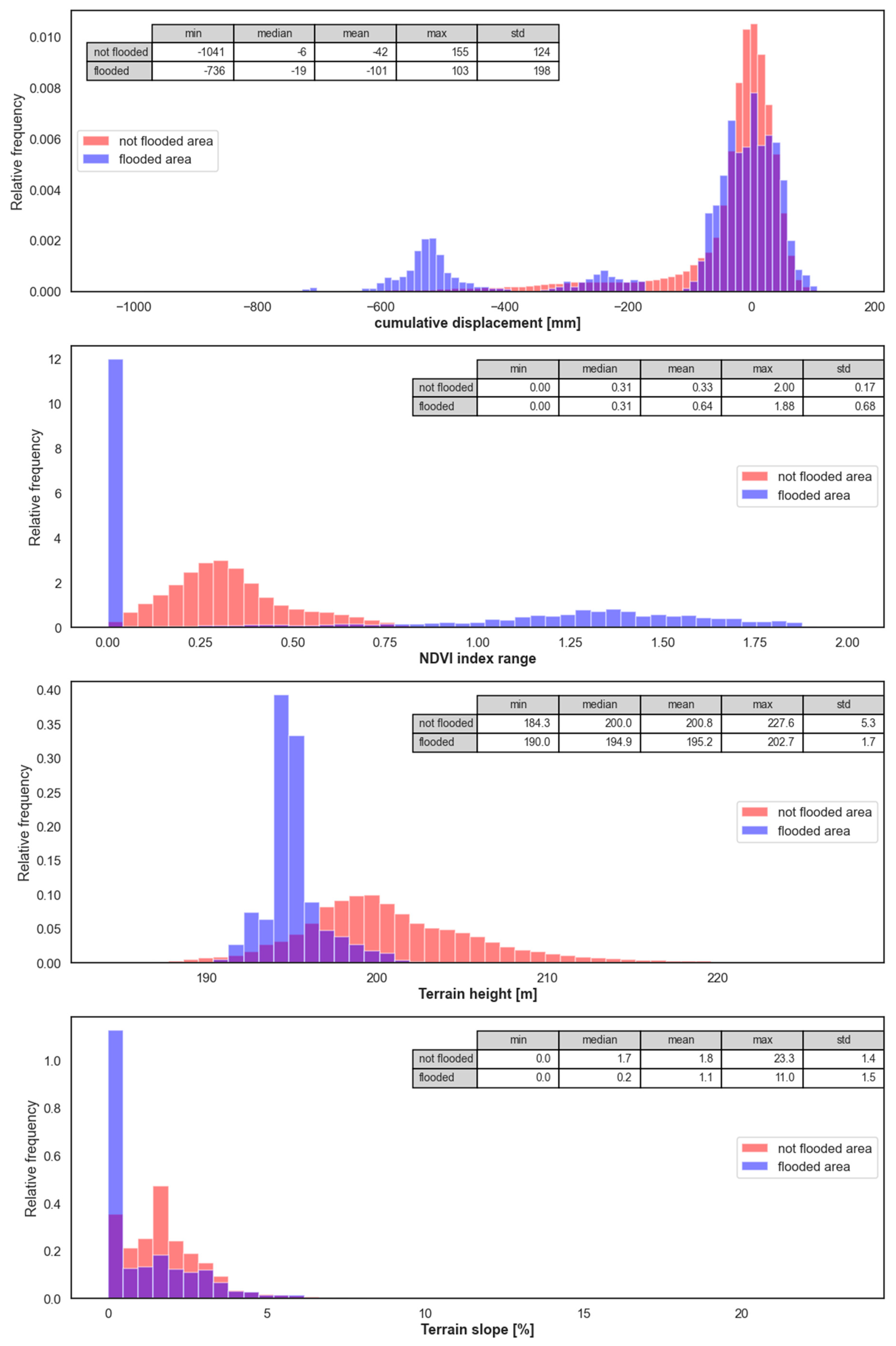
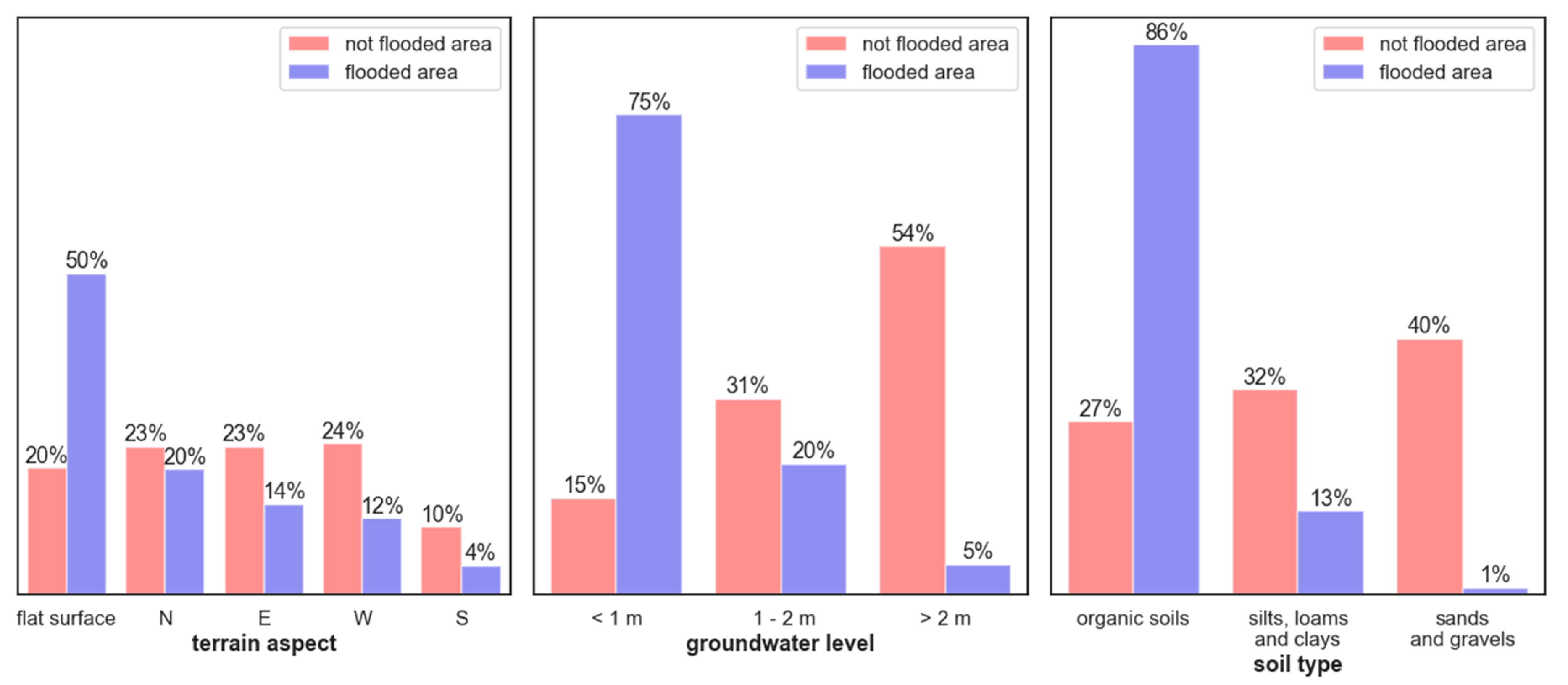
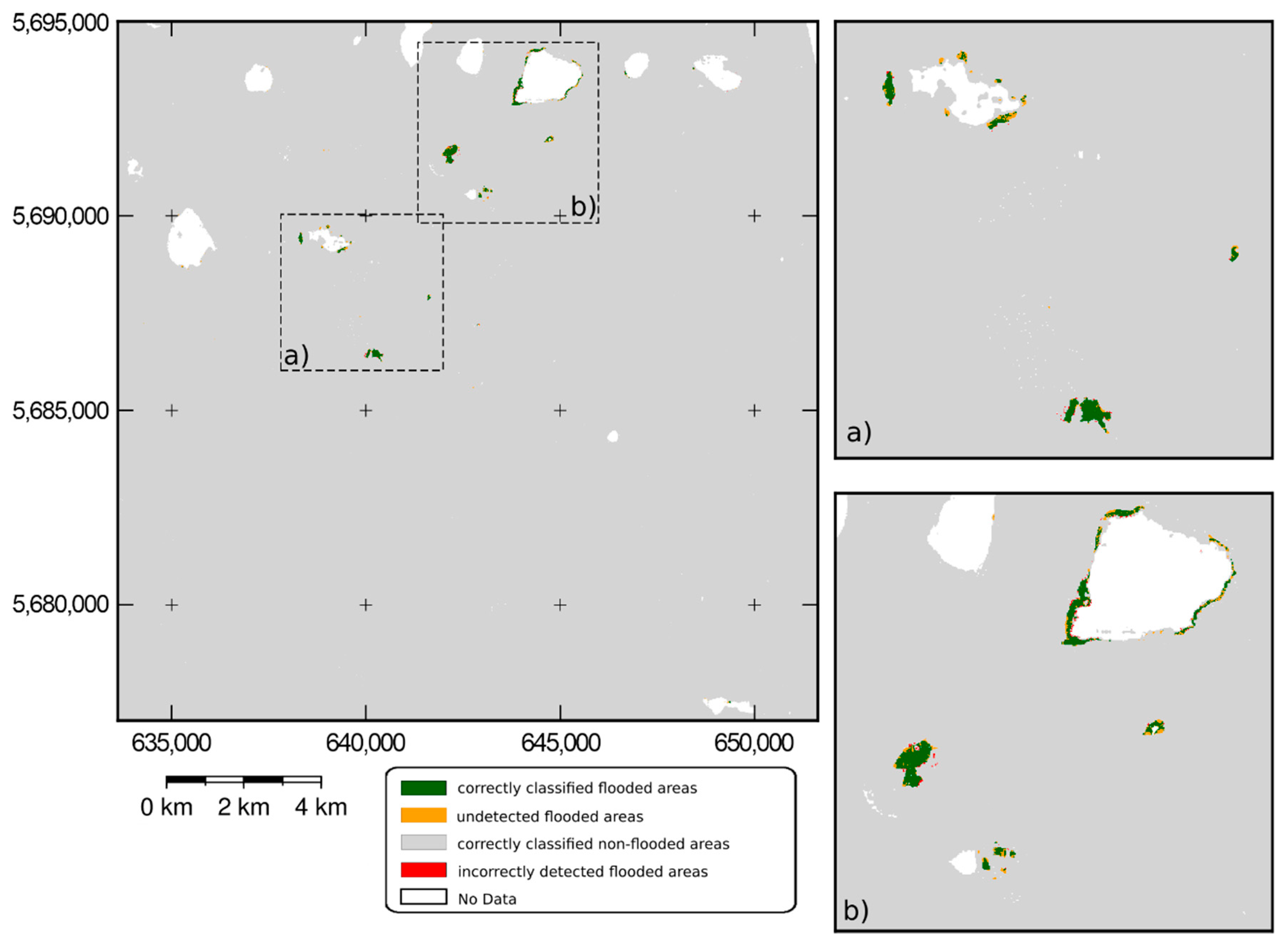
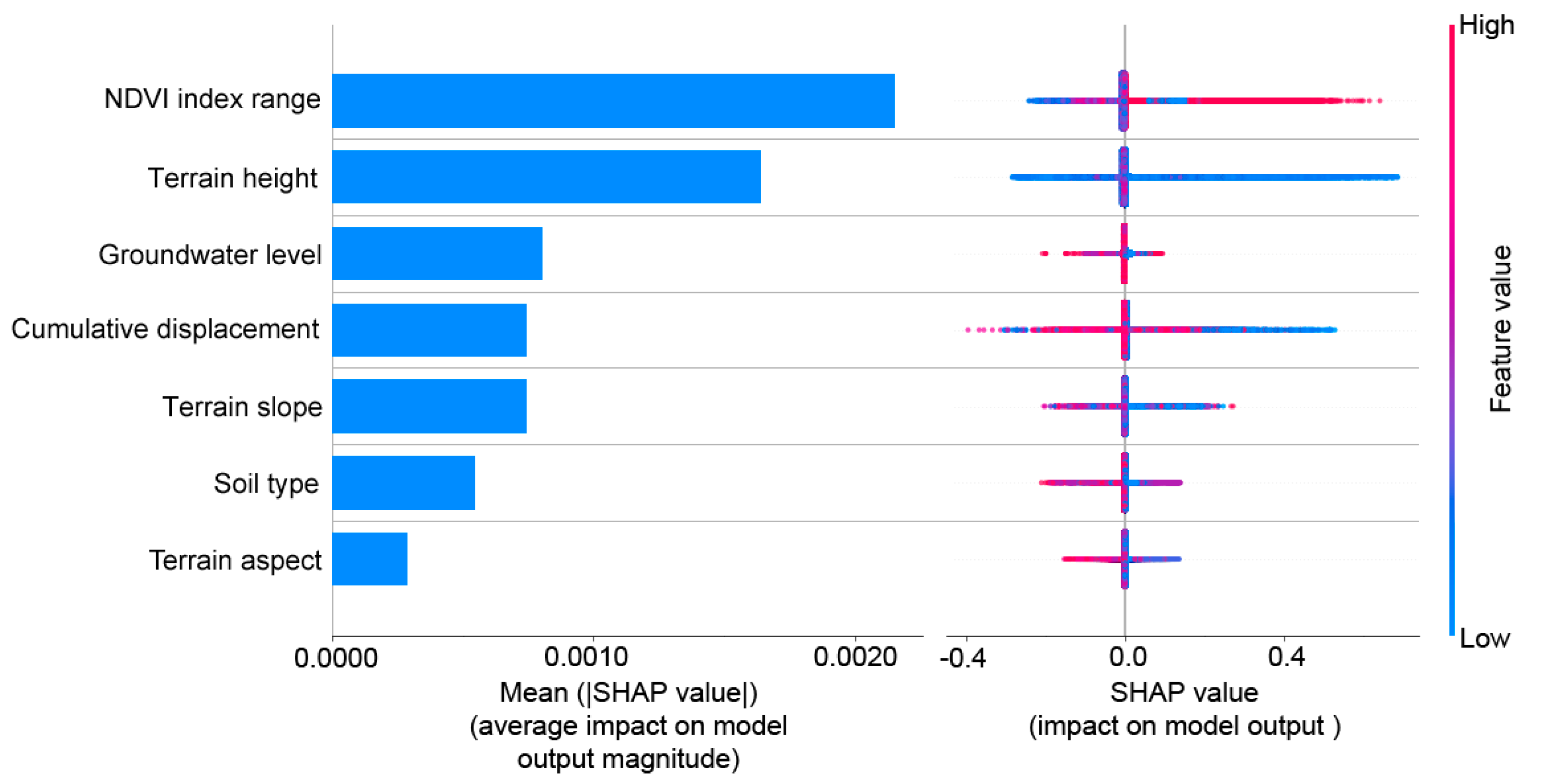
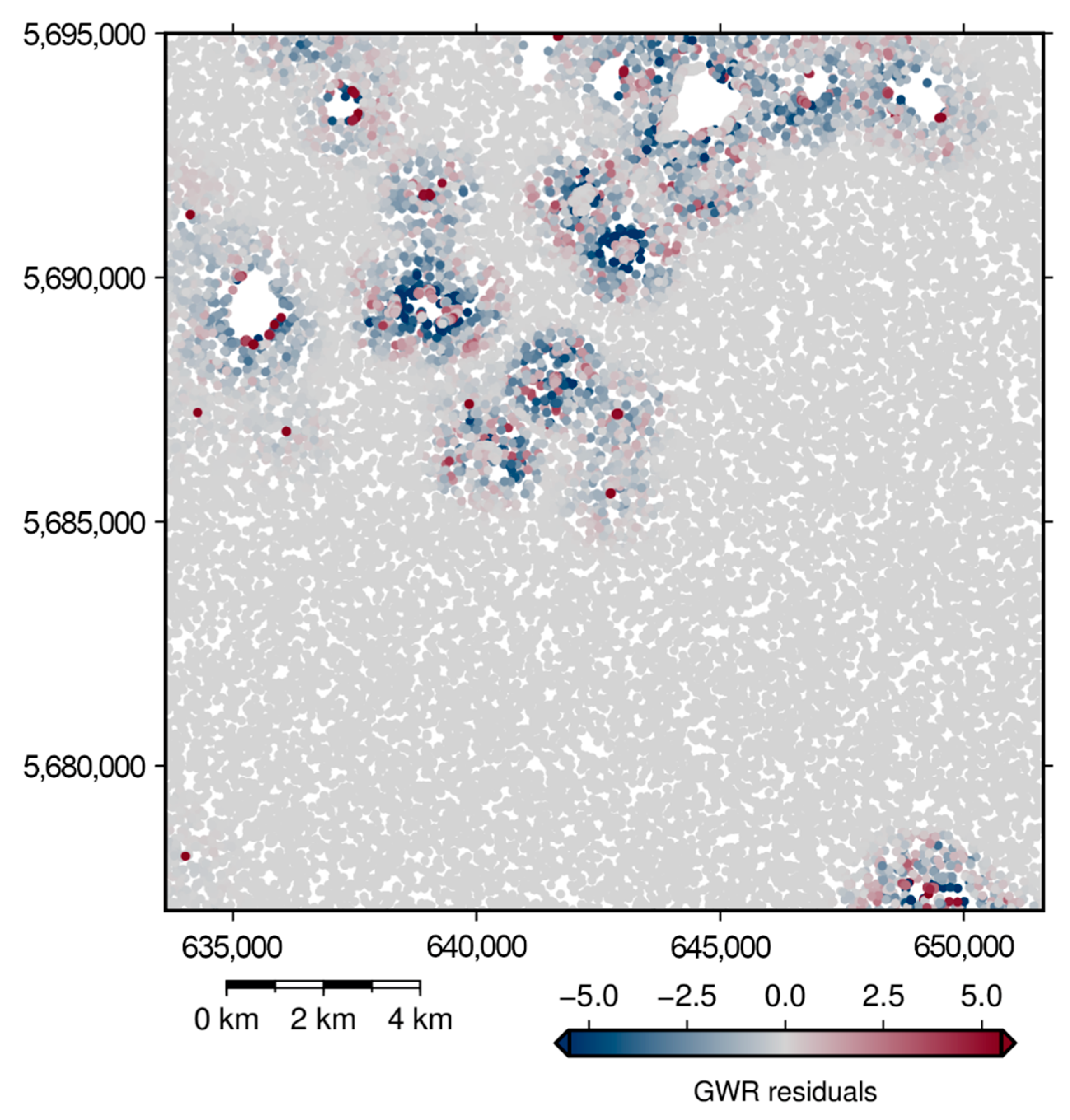
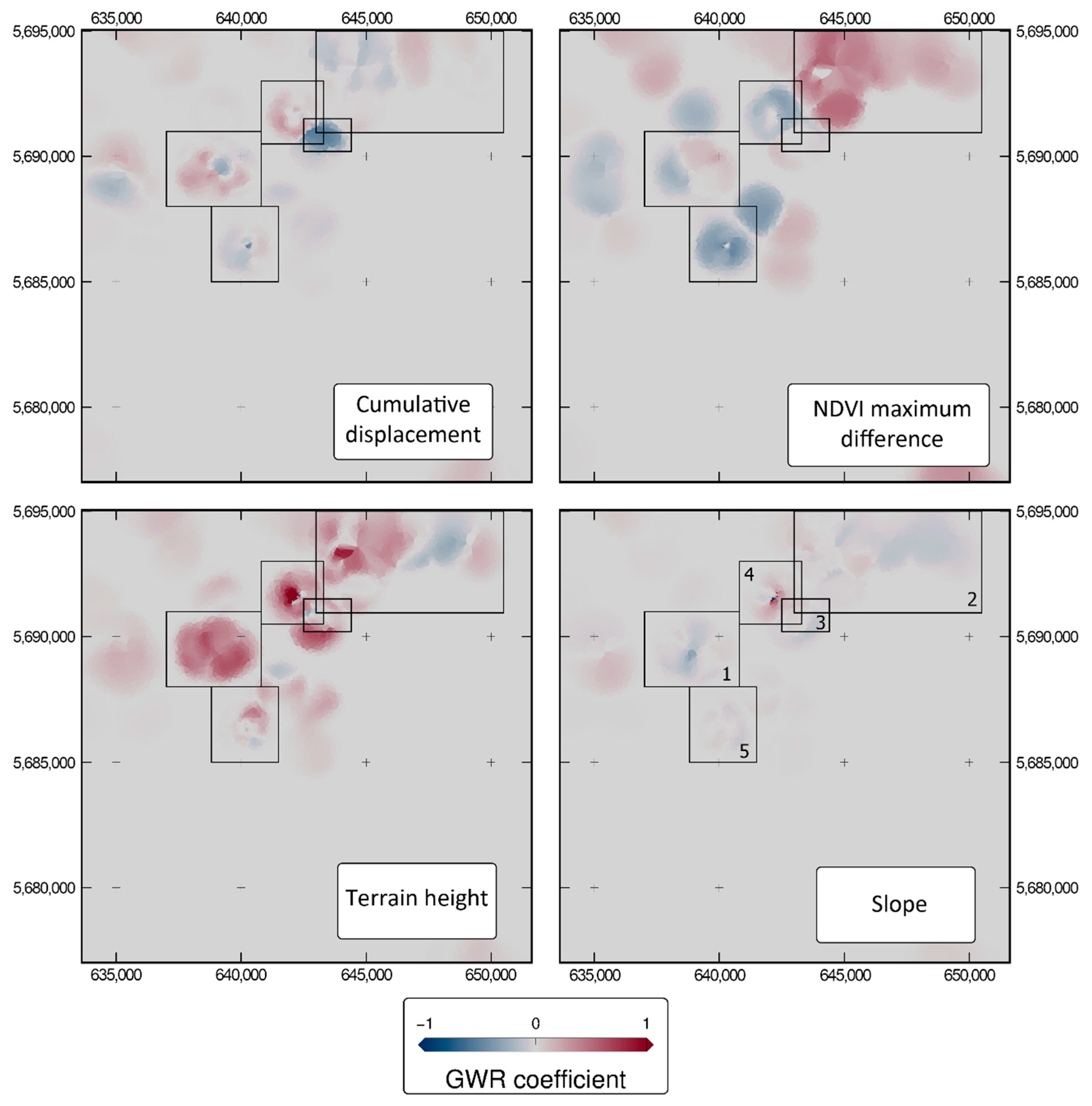
| Source | Area of Interest | Issues | Satellite Data | Methods |
|---|---|---|---|---|
| [21] | Amynteon mine (Greece) | Impact of mining activities on terrain and water resource | Landsat-5 and Landsat-7, SPOT and ASTER | Unsupervised classification techniques in GIS |
| [22] | The PT Freeport Indonesia (Indonesia) | Impact of mining activities on land cover | Landsat-5 | Three false-color composite image |
| [23] | Lignite mine “Belchatów”, (Poland) | Impact of mining on hydrogenic habitats | Landsat-5 and Landsat-7 | Normalized Difference Vegetation Index (NDVI) |
| [24] | Coal mine in Tangshan, (China) | Impact of mining activities on terrain | ETM, SPOT-4, SPOT-5 and IKONOS | Multi-spectral composite imagery |
| [25] | Lignite mines (eastern Germany) | Monitoring of the environment and reclaimed areas | Landsat-TM and ERS-1 | Maximum Likelihood Classification of Landsat Thematic Mapper |
| [27] | Coal mine in Gangwon-do (South Korea) | Subsidence analysis in a mining area | JERS-1 | SBAS algorithm and GIS |
| [28] | Two coalfields, Bulianta and Shangwan (China) | Determination of common features of deformations detected in two areas | ALOS PALSAR | SBAS processing |
| [29] | Coal mines in the Greater Region of Luxembourg (the French–German border) | Mapping coal mining-related ground subsidence and uplift | ERS-1/2 and ENVISAT | SBAS processing |
| [30] | The Northumberland and Durham coalfield (United Kingdom) | Investigation terrain motion and groundwater level change phenomena | ERS, ENVISAT and Sentinel-1 | Intermittent SBAS technique |
| [31] | The South Wales Coalfield (United Kingdom) | Monitoring of uplift caused by pumping groundwater | ERS-1/2 | Intermittent SBAS technique |
| [20] | Mine of coal and metal ores, Kirchheller Heide (Germany) | Landscape dynamics and extensive soil movement | Landsat ETM+ | Random Forest, Spectral Mixture Analysis (SMA), Normalized Difference Vegetation Index (NDVI) |
| [32] | The Three Gorges Reservoir area (China) | Prediction of groundwater level | - | Classification and regression tree (CART) |
| [26] | The southwestern part of Ritu county, Bahrain | Assessment of groundwater potential | Landsat 8 OLI 7/5/3 | Multi-criteria decision model (MCDM) integrated with decision tree techniques (C5.0) and CART |
| [33] | Sichuan Province (China) | Predicting displacement of landslide | - | Least Square Support Vector Machines (LSSVM), Genetic Algorithm (GA) |
| [34] | Darling River Floodplain (Australia) | Modeling of wetlands | - | Random Forest |
| Index | Mathematical Formula 1 | Source |
|---|---|---|
| NDVI | [43] | |
| MNDWI | [44] |
| No. | Name | Description |
|---|---|---|
| 1 | NDVI Range | Based on the Sentinel-2 imagery obtained for April, during the years 2016–2019 (Section 2.3) |
| 2 | LOS terrain displacements | Based on the Sentinel-1 SAR data, 5 rasters: October 2015, April 2016–2019 (Section 2.4) |
| 3 | Groundwater depth | Divided into 3 categories (Section 2.5) |
| 4 | Geological classification of soil | Divided into 3 categories, depending on the soil susceptibility to water retention (Section 2.5) |
| 5 | DEM | SRTM 1” |
| 6 | Slope | Based on the DEM, values in % |
| 7 | Exposure | Based on the DEM, values generalized to 4 main geographic directions and flat terrain |
| 8 | Identified floodplains | Based on the MNDWI values (Section 2.3) |
| Precision | Recall | F-1 Score | |
|---|---|---|---|
| Non-flooded area | 99.97% | 99.99% | 99.98% |
| Flooded area | 93.42% | 75.85% | 83.73% |
| Predicted | |||
|---|---|---|---|
| Non-Flooded Area | Flooded Area | ||
| True | Non-flooded area | 3,173,140 | 238 |
| Flooded area | 1076 | 3380 | |
| Variable | Mean | Std. | Min. | Median | Max. | p-Value |
|---|---|---|---|---|---|---|
| Cumulative displacement | −0.01 | 0.08 | −0.66 | 0.00 | 0.33 | 0.00 |
| NDVI maximum difference | −0.02 | 0.14 | −0.54 | 0.00 | 0.61 | 0.54 |
| Terrain height | −0.10 | 0.33 | −8.13 | 0.00 | 2.28 | 0.00 |
| Slope | 0.00 | 0.14 | −1.98 | 0.00 | 4.06 | 0.00 |
Publisher’s Note: MDPI stays neutral with regard to jurisdictional claims in published maps and institutional affiliations. |
© 2020 by the authors. Licensee MDPI, Basel, Switzerland. This article is an open access article distributed under the terms and conditions of the Creative Commons Attribution (CC BY) license (http://creativecommons.org/licenses/by/4.0/).
Share and Cite
Kopeć, A.; Trybała, P.; Głąbicki, D.; Buczyńska, A.; Owczarz, K.; Bugajska, N.; Kozińska, P.; Chojwa, M.; Gattner, A. Application of Remote Sensing, GIS and Machine Learning with Geographically Weighted Regression in Assessing the Impact of Hard Coal Mining on the Natural Environment. Sustainability 2020, 12, 9338. https://doi.org/10.3390/su12229338
Kopeć A, Trybała P, Głąbicki D, Buczyńska A, Owczarz K, Bugajska N, Kozińska P, Chojwa M, Gattner A. Application of Remote Sensing, GIS and Machine Learning with Geographically Weighted Regression in Assessing the Impact of Hard Coal Mining on the Natural Environment. Sustainability. 2020; 12(22):9338. https://doi.org/10.3390/su12229338
Chicago/Turabian StyleKopeć, Anna, Paweł Trybała, Dariusz Głąbicki, Anna Buczyńska, Karolina Owczarz, Natalia Bugajska, Patrycja Kozińska, Monika Chojwa, and Agata Gattner. 2020. "Application of Remote Sensing, GIS and Machine Learning with Geographically Weighted Regression in Assessing the Impact of Hard Coal Mining on the Natural Environment" Sustainability 12, no. 22: 9338. https://doi.org/10.3390/su12229338
APA StyleKopeć, A., Trybała, P., Głąbicki, D., Buczyńska, A., Owczarz, K., Bugajska, N., Kozińska, P., Chojwa, M., & Gattner, A. (2020). Application of Remote Sensing, GIS and Machine Learning with Geographically Weighted Regression in Assessing the Impact of Hard Coal Mining on the Natural Environment. Sustainability, 12(22), 9338. https://doi.org/10.3390/su12229338





